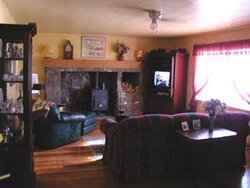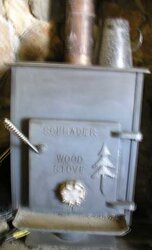I live in a rural area in the northern US Rockies. I'm thinking of getting a new wood stove to replace my current one. My house is small--1200 sq. ft.--with a fairly open floor plan and the current stove is capable of heating the whole house. It sits in a large stone and masonry alcove that's the dramatic focal point of the living room end of the great room (the alcove looks like a huge, walk-in stone fireplace that's capped with a rough-hewn, pine mantel, but it's really an alcove built for the stove); the great room takes up half of the house's footage. I want to place the new stove in the alcove, too. The current stove has a heat shield and sits very close to the back wall of the alcove.
I saw a couple of less expensive stoves that I'm interested in--a Drolet and a Century (I know about this company's financial problems)--at the Ace hardware in the nearest town. I was in town again today and made the mistake of stopping in at one of the wood stove specialty stores. They sell a few high end stoves as well as a lot of mid-level stoves, like Vermont Castings; however, their prices are very, very high. The staff talking to me, including one of the contract installers in the area, turned rather rude when I mentioned that I'm seriously interested in some less expensive stoves elsewhere. When I asked the contract installer if he would be willing to come to my house to look at what the job would take and give me a cost estimate, he stated that there might be clearance issues with the alcove (he truthfully isn't interested in the job since I'm not going to buy from this store--he didn't even want to give me his phone number). I hadn't measured the alcove so I didn't know it's exact dimensions (the interior dimensions are 4'7" H, 2'7" D, 6'6" W). I was surprised at the installer's comments, since it's constructed of all non-combustible materials (and I mentioned this), including a deep cement pad for the flooring. Am I now going to be limited to looking at a zero clearance stove like the Osborn 1100?
I've attached a picture of the alcove.
I saw a couple of less expensive stoves that I'm interested in--a Drolet and a Century (I know about this company's financial problems)--at the Ace hardware in the nearest town. I was in town again today and made the mistake of stopping in at one of the wood stove specialty stores. They sell a few high end stoves as well as a lot of mid-level stoves, like Vermont Castings; however, their prices are very, very high. The staff talking to me, including one of the contract installers in the area, turned rather rude when I mentioned that I'm seriously interested in some less expensive stoves elsewhere. When I asked the contract installer if he would be willing to come to my house to look at what the job would take and give me a cost estimate, he stated that there might be clearance issues with the alcove (he truthfully isn't interested in the job since I'm not going to buy from this store--he didn't even want to give me his phone number). I hadn't measured the alcove so I didn't know it's exact dimensions (the interior dimensions are 4'7" H, 2'7" D, 6'6" W). I was surprised at the installer's comments, since it's constructed of all non-combustible materials (and I mentioned this), including a deep cement pad for the flooring. Am I now going to be limited to looking at a zero clearance stove like the Osborn 1100?
I've attached a picture of the alcove.



